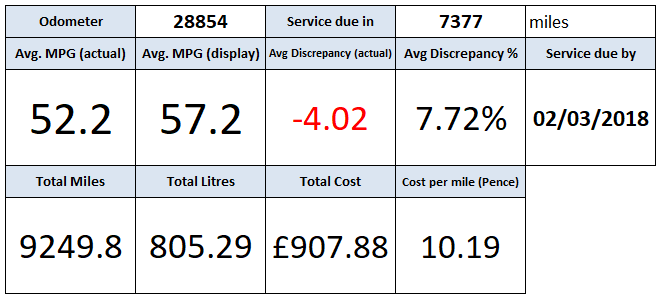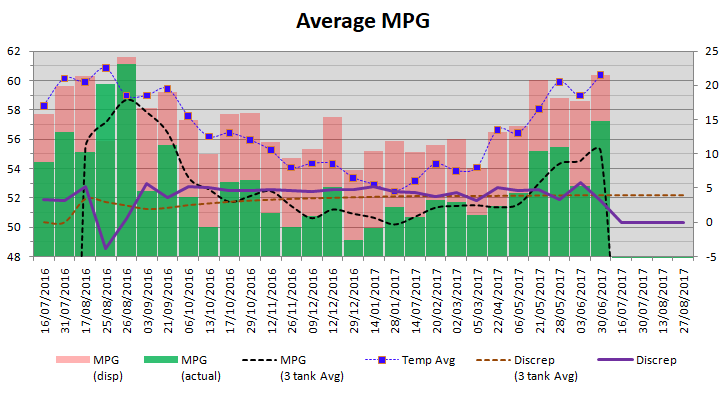Hybrids in hot and cold weather – 1 year with the Lexus CT200h
I’ve had my Lexus CT200h for 1 year now, and in that time I have been logging my fuel economy on a spreadsheet so that I can get an idea of how it performs over the year with different driving types and different temperatures.
Here are some notes to add before we look at the data:
- Most of my driving is commuting 15 miles per direction, and I tried to average around 60mph for the majority of this 1 year period for the sake of this test.
- Long journeys, which I do a few times a year, were done at 70mph.
- Short journeys to the supermarket once or twice per week.
- In March 2017 I did barely any driving, but this shouldn’t have impacted the data.
- I was using “pulse and glide” after I discovered it, for the majority of the year.

Hopefully most this table should be self explanatory. Discrepancy is the difference between what MPG the car said it got and what was worked out on a fill up.

The graph looks complicated but is quite simple.
- The green bars represent the real MPG as calculated by filling the tank
- The red bars represent the MPG the car said it was getting.
- The blue line is a representation of outdoor temperature calculated by taking 2 values, the minimum and maximum temperatures during that tank of fuel, and averaging them. It’s not an accurate representation of outdoor temperature (I would have to log it all the time to do that) but an average representation so you can see a trend.
- The dark orange line is the average discrepancy in MPG between the actual MPG and what the car said it was getting.
- The purple line is the discrepancy for that tank of fuel.
- The black line is a running average MPG calculated over the last 3 tanks, to make it easier to compare with temperature.
OK, how you’ve had a second to digest the data on the graph, lets talk about it.
What is the first thing we can tell from this data?
Plain and simply, hybrids work better when it’s warmer. Why? Because the engine gets up to working temperature quicker and which means it can shut off the engine earlier so the electric part of the hybrid system can do what it is designed to do. You can apply this rule to pretty much any vehicle.
Why is there a discrepancy between the displayed and actual MPG?
This can be caused by a few things, with the most likely being speedo calibration. The vehicle reads about 4mph too high at 66mph (so it’s reading 70mph at this point) as checked by GPS, which is a 5.8% difference. Tyres can cause this but I just got new tyres and it looks to be the same (though I haven’t checked it accurately, only via the speed limit symbol on the GPS turning red when you speed). Most cars in the UK over read very slightly.
This 5.8% is mostly accounted for in the 5-9% discrepancy that we see in the data (I’ll share the full Excel document at the end of this blog which contains more data). The remaining could be put down to tyre pattern and pressures, weight in the vehicle, etc.
Once you know roughly how far out your vehicle is, it’s easy to take the reading and subtract a few MPG to get the real MPG.
What economy do I get at XX mph?
As a rough estimate based on my observations:
- <35mpg in town on a short journey from cold
- >50mpg in town if engine is warm
- ~53mpg at 60mph on a 15mi journey
- ~53mpg at 70mph on a long journey
These figures will change based on your driving style, how much you demand from the heating or A/C, weight, tyre pressures, your driving route, etc.
What average economy do I get?
According to all of the data that I have collected, which is every fuel-up for 1 year, and with a mix of driving types and speeds, I saw an average of 52.2mpg over the 12 month period. This is 30% below the rated 74.3mpg combined rating, which was expected because these ratings are recorded under artificial conditions.
The highest I saw was 61.1mpg on a long journey at 70mph, where I barely had to change speed for 150 miles and it was pretty warm. I don’t know if this was fluke or real, but I have never managed an MPG this high since. Temperature has only just reached similar conditions recently so this is likely why.
Everything else aside, 52.2mpg is impressive for a vehicle running a petrol engine, and outperforms many diesel vehicles too.
My previous car, a VW Passat 2.0 TDI was managing around 44-46mpg. I have friends with diesel vehicles such as a Ford Mondeo 2.0 TDCI which averages around 45mpg.
Whilst there are cars out there that will do more than 52.2mpg, chances are they aren’t doing it whilst abiding by emissions laws (remember the whole dieselgate scandal from VW).
The average economy of the CT200h on Fuelly.com shows as being around 49mpg, which means that I was driving a little above the average economy wise, probably due to going most places at 60mph for this test.
 2013 Lexus CT200h average fuel economy. Source: Fuelly.com
2013 Lexus CT200h average fuel economy. Source: Fuelly.com
Summary
So, do hybrids really work? Yes, they do, at least in my personal experience. But there are still conditions under which they’ll perform no better than any other car, with the biggest being in cold weather and short journeys. If you have a particularly heavy right foot all the time you may also not see much benefit, but I can’t testify to that.
